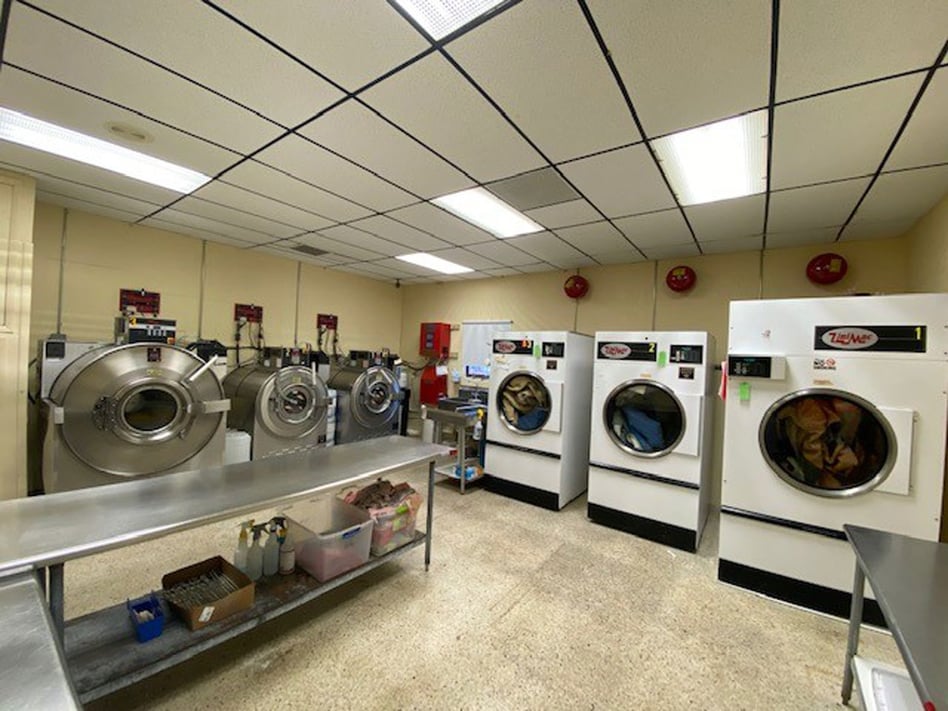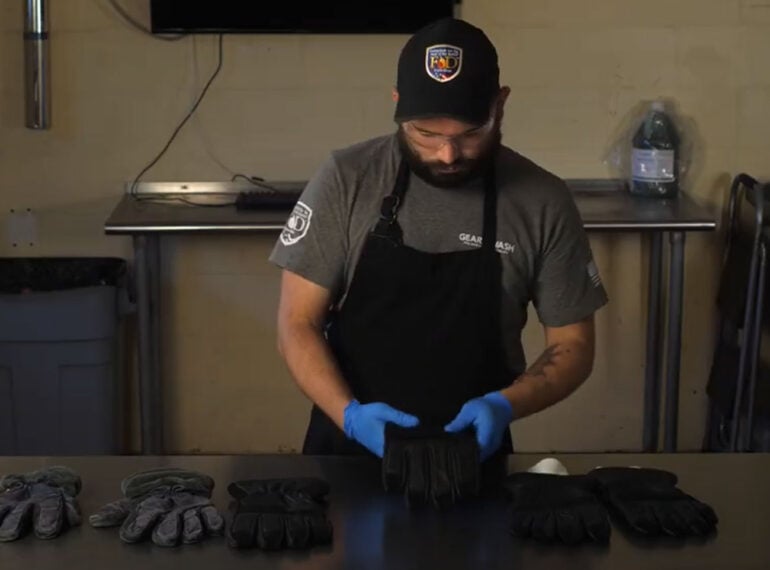
This article first appeared in International Firefighter.
Gear preservation is an essential part of any firefighter’s job, and Gear Wash understands the importance of managing a high-quality program of inspecting, cleaning and repairing firefighting gear – everything from turnouts to gloves, helmets, hoods and boots.
Gear Care Is an NFPA requirement
In 2020, the National Fire Protection Association (NFPA) released changes to its 1851 standard governing the care and maintenance of firefighting gear. The updates include modifications to the minimum requirements for gear inspections (once a year) and cleanings (twice yearly). Changes also emphasize the fire department’s responsibility to document all cleanings and to train personnel in protective garment care procedures. Additionally, the update specifies that cleaning processes used by ISPs be verified annually by independent laboratories for their effectiveness in cleansing garments of contaminates and carcinogens.
NFPA 1851 emphasizes the critical need to protect the performance properties of firefighting gear. Exposure to heat, smoke and other harmful substances can break down materials used to make the gear or reduce barrier properties designed to keep the wearer safe. In addition, soiled gear can provide less breathability, which can increase the risk of heat stress.
Inspection is the first step
Gear Wash is verified to meet the highest standards for proper gear maintenance, from the initial wash to inspection and quality repairs. Our associates take time to examine firefighting gear on a closer level to identify any structural or fabric problems that might compromise the quality of its performance, as well as signs of soiling and contamination that may pose a health risk. Gear is then cleaned, sanitized and decontaminated using specialized detergents and cleaning processes to remove harmful particulates and residues. If gear is damaged, associates may perform a series of repairs such as stitching, patches or reflective trim replacement.
Gear should be removed from active service and thoroughly cleaned anytime it has become soiled. Also, at a minimum, the NFPA recommends all issued gear be machine cleaned at least twice a year – once every six months. Cleaning can be performed by a manufacturer or verified ISP.
The following tips can help fire departments perform a thorough inspection of their gear and identify signs of damage that a verified ISP can help to remedy. In all cases, the individual handling soiled gear should wear a pair of examination-grade gloves, an apron and a pair of safety glasses to protect against harmful substances potentially deposited on the gear.

How to inspect gloves
Begin by examining gloves for physical damage like rips, tears and cuts as well as thermal damage such as charring, burn holes, melting or discoloration of any layer. Gloves should also be examined for signs of shrinkage, a loss of elasticity or flexibility, a loss of seam integrity such as broken or missing stitches, or for the presence of an inverted glove liner. Lastly, gloves should be tested for water integrity using a utility sink or other container of sufficient size.
Fill the sink with warm water (less than 105°F or 40°C), put the gloves on and submerge them up to the wrist crease, making sure no water gets in over the top. Next, repeatedly open and close your hands for two minutes. Now remove the gloves from the water and remove the gloves from your hands – if any water has seeped through the gloves and onto your hands, the gloves have failed the water integrity test and should be thrown away. If no water has leaked through, the gloves can be hung up to dry and then returned to service or sent for cleaning as required.
How to inspect helmets
Begin by examining the shell of the helmet for evidence of physical damage like cracks, crazing, dents or abrasions. Also check for thermal damage to the shell, like bubbling, soft spots, warping or discoloration. Next, examine the ear flaps for rips, tears and cuts as well as thermal damage like charring, burn holes or melting. Inspectors should also check for any damage or missing components of suspension/retention systems.
Moving on to the face shield and goggles system, inspectors should look for discoloration, crazing and scratches to the face shield and goggles (or anything that may limit visibility). Finally, be sure to check for any damaged or missing reflective trim and for a loss of seam integrity such as broken or missing stitches.
How to inspect turnout gear
When examining turnout gear, the outer shell, moisture barrier and thermal liner should be inspected for the following:
- Physical damage to all layers and sides of each layer such as rips, tears, cuts and abrasions.
- Thermal damage indicated by charring, burn holes, melting or discoloration of any layer.
- Any loss of seam integrity such as broken or missing stitches as well as loose or missing moisture barrier seam tape.
- Material physical integrity including UV or chemical degradation as evidenced by discoloration, significant changes in material texture, loss of material strength, loss of liner material or shifting of liner material.
- Delamination as evidenced by separation of film from substrate fabric, flaking or powdering.
Finally, the moisture barrier should be tested using the hydrostatic test to evaluate the water penetration barrier. ISPs can perform this test using a moisture barrier tester. Fire departments may also invest in a portable tester that meets the NFPA 1851 standard. In all cases, the test should show no leakage and the result of each evaluation should be recorded.
How to inspect hoods
Hoods should also be inspected for signs of physical damage (rips, tears, cuts) and thermal distress (charring, burn holes, melting, discoloration). Next, check for any loss of face opening adjustments while also looking for loss of seam integrity such as broken or missing stitches. Finally, if examining a particulate blocking hood, be sure to look for damage to the particulate blocking layer.
How to inspect boots
When inspecting boots, signs of physical damage will commonly include cuts, tears and punctures. Also check for thermal damage including exposed or deformed areas of the protective toe, protective midsole and shank. Next, look for a loss of water resistance by submerging boots in water similar to the steps described for inspecting fire gloves.
Boots showing compromised water integrity should also be discarded immediately. Finally, check the boot closure system for component damage and functionality, and look for a loss of seam integrity such as broken or missing stitches.
Know when to retire gear
Any gear showing obvious soiling or signs of distress should be relegated for cleaning and/or repair. It is also important to know when care and maintenance are not enough and it’s time to retire gear. NFPA guidelines require turnout gear to be retired 10 years from the date of manufacture. However, oftentimes turnout gear needs to be replaced before the 10-year mark. Once the protective properties of the gear have diminished, it is no longer safe to use. Bunker gear needs to be retired before the 10-year mark for reasons including:
- Contamination from an incident that makes it either unsafe to handle or unable to be effectively cleaned and returned to service.
- Exposure to extreme fireground temperatures, resulting in significant damage to protective properties.
- The gear has been worn down or is beyond repair.
- The gear is no longer compliant with NFPA standards.
- Maintenance costs have exceeded the remaining useful life of the gear.
Many other circumstances can make gear ineffective, so it’s crucial to have it serviced by a certified ISP for advanced cleaning and inspection. Additionally, an ISP can offer the best recommendations on repairs and when to retire gear.
Keep gear clean
Strictly adhering to NFPA 1851 guidelines can be the difference between effective and ineffective PPE and extending the life of your gear. Follow the gear manufacturer’s recommendations and regularly clean firefighting gear. Laundering gear through verified ISPs like Gear Wash helps to maximize the effectiveness of the advanced fabric and ensures the gear will be protected while reducing the risk of secondary exposure to toxins and carcinogens. We also provide repair and alteration services as well as offer rental gear for departments in temporary need.
While turnouts aren’t in use or being repaired or laundered, departments should take time to carefully inspect and safely store their gear, helping to ensure a long life of safe firefighting ahead.




